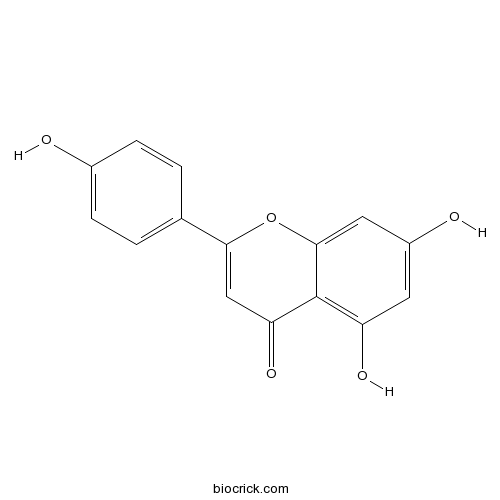Scutellaria indica
Scutellaria indica
1. The products in our compound library are selected from thousands of unique natural products; 2. It has the characteristics of diverse structure, diverse sources and wide coverage of activities; 3. Provide information on the activity of products from major journals, patents and research reports around the world, providing theoretical direction and research basis for further research and screening; 4. Free combination according to the type, source, target and disease of natural product; 5. The compound powder is placed in a covered tube and then discharged into a 10 x 10 cryostat; 6. Transport in ice pack or dry ice pack. Please store it at -20 °C as soon as possible after receiving the product, and use it as soon as possible after opening.
Natural products/compounds from Scutellaria indica
- Cat.No. Product Name CAS Number COA
-
BCN5658
Apigenin520-36-5
Instructions

Rapid identification and quantitative analysis of the chemical constituents in Scutellaria indica L. by UHPLC-QTOF-MS and UHPLC-MS/MS.[Pubmed: 26350559]
Ultra high performance liquid chromatography (UHPLC) coupled with a hybrid quadrupole time-of-flight mass spectrometry (QTOF-MS) was used to separate and identify the compounds in Scutellaria indica L. Fragmentation patterns of these compounds were investigated by the UHPLC-QTOF-MS technique in both negative and positive ion modes. By using this strategy, both intact precursors and fragment ions information were obtained from a single injection. A total of 42 phenolic and other compounds were unequivocally or tentatively identified from S. indica for the first time. Among them, 8 phenolic compounds: scutellarin, luteolin, naringenin, wogonoside, apigenin, hispidulin, wogonin and chrysin were further quantified and used as marker substances by multiple-reaction monitoring in negative ionization mode. The results demonstrated that the calibration curves for all analytes showed good linearity (R(2)>0.9992) within the test ranges. The overall limits of detection and limits of quantification were 0.12-10.52 ng/mL and 4.67-20.22 ng/mL, respectively. The recovery was 96.02-102.88% with a relative standard deviation of less than 3.02%. It is proposed that the methods described here can be applied for rapid evaluation, quality control and authenticity establishment of S. indica.
Multi-constituent determination and fingerprint analysis of Scutellaria indica L. using ultra high performance liquid chromatography coupled with quadrupole time-of-flight mass spectrometry.[Pubmed: 26333027]
An ultra-performance liquid chromatography coupled with quadrupole time-of-flight mass spectrometry method integrating multi-constituent determination and fingerprint analysis has been established for quality assessment and control of Scutellaria indica L. The optimized method possesses the advantages of speediness, efficiency, and allows multi-constituents determination and fingerprint analysis in one chromatographic run within 11 min. 36 compounds were detected, and 23 of them were unequivocally identified or tentatively assigned. The established fingerprint method was applied to the analysis of ten S. indica samples from different geographic locations. The quality assessment was achieved by using principal component analysis. The proposed method is useful and reliable for the characterization of multi-constituents in a complex chemical system and the overall quality assessment of S. indica.
Characterization and quantification of the chemical compositions of Scutellariae Barbatae herba and differentiation from its substitute by combining UHPLC-PDA-QTOF-MS/MS with UHPLC-MS/MS.[Pubmed: 25766849]
The aim of this study was to investigate the possibility of using the non-official species Scutellaria indica L. as the substitute for the official species Scutellaria barbata D. Don. A sensitive, precise and accurate method was developed to identify their chemical compositions from the crude extracts using UHPLC-PDA-QTOF-MS/MS. 36 peaks were detected and 28 peaks have been tentatively and structurally characterized by comparing their retention times, UV spectra and HR-MS data with those of the reference substances and/or the data of the literatures. Additionally, 5 flavonoids have been quantified by multiple reaction monitoring (MRM) in the negative ionization mode. The results demonstrated that there were 23 common peaks between these two species. However, the other 13 peaks from S. barbata could not be detected in S. indica. Furthermore, the content of 5 flavonoids is significantly different. Scutellarein cannot be detected in S. indica, which was considered as the characteristic component for distinguishing the two species. Our data, therefore, clearly demonstrate that S. indica may not be used as the substitute for S. barbata and further investigation is needed to determine through investigation of their therapeutic efficacy.
Anti-inflammatory activity of phenolic compounds from the whole plant of Scutellaria indica.[Pubmed: 25637363]
Six new phenolics, scutellariosides A-F (1-3, 5-6, and 8), together with six known compounds (4, 7, 9-12) were isolated from the whole plant of Scutellaria indica (Labiatae). The chemical structures of these compounds were determined by spectroscopic analyses including 2D NMR. Their anti-inflammatory activities were evaluated against LPS-induced NO production in macrophage RAW 264.7 cells. Among them, compounds 10-12 had inhibitory effects with IC50 values ranging from 7.2 to 27.8μM. Compound 12 reduced LPS-induced iNOS expression in a dose-dependent manner.
Arginase II inhibitory activity of flavonoid compounds from Scutellaria indica.[Pubmed: 23604721]
Arginase II has recently reported as a novel therapeutic target for the treatment of cardiovascular diseases such as atherosclerosis. In the course of screening plants used in natural medicines as arginase II inhibitory activity, a methanol extract of Scutellaria indica showed significant inhibitory effect. Further fractionation and repeated column chromatography led to the isolation of a new flavan-type (1), and seven known compounds (2-8). The chemical structures of isolated compounds were elucidated based on extensive 1D and 2D NMR spectroscopic data. The isolates 1-8 were investigated in vitro for their arginase II inhibitory activity using enzyme solution prepared from kidney of anesthetized C57BL/6 mice. Compounds 3 and 5 significantly inhibited arginase II activity with IC₅₀ values of 25.1 and 11.6 μM, respectively, whereas the other compounds were apparently inactive.
Characterization of 24 transferable microsatellite loci in four skullcaps (Scutellaria, Labiatae).[Pubmed: 22203648]
Transferable polymorphic microsatellite loci for four skullcaps, Scutellaria indica, S. taiwanensis, S. austrotaiwanensis, and S. playfairii, were developed for future studies of the mating system and population structure of these species. Interspecific amplification was also tested in various Scutellaria species.


